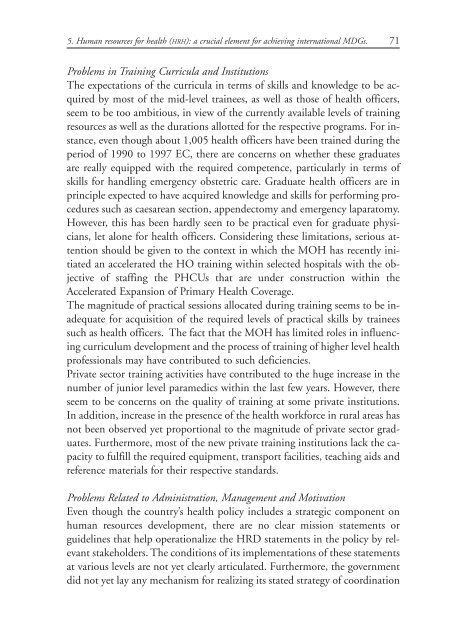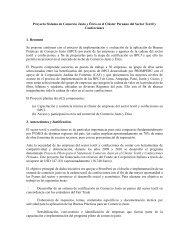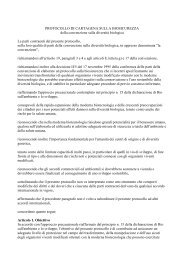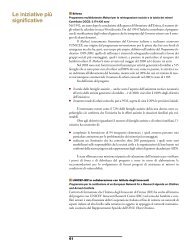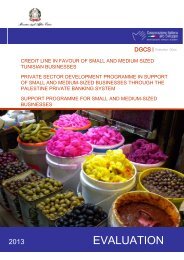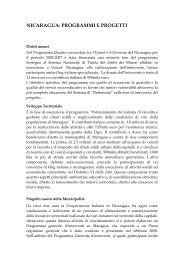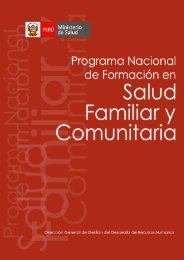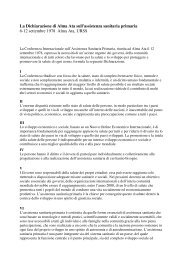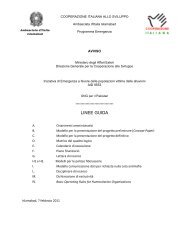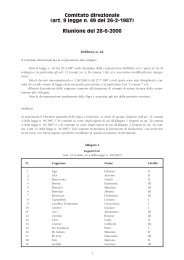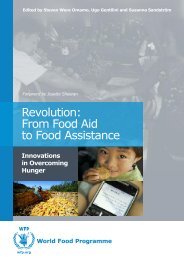FRONTESPIZIO - Cooperazione Italiana allo Sviluppo
FRONTESPIZIO - Cooperazione Italiana allo Sviluppo
FRONTESPIZIO - Cooperazione Italiana allo Sviluppo
Create successful ePaper yourself
Turn your PDF publications into a flip-book with our unique Google optimized e-Paper software.
5. Human resources for health (HRH): a crucial element for achieving international MDGs. 71Problems in Training Curricula and InstitutionsThe expectations of the curricula in terms of skills and knowledge to be acquiredby most of the mid-level trainees, as well as those of health officers,seem to be too ambitious, in view of the currently available levels of trainingresources as well as the durations <strong>allo</strong>tted for the respective programs. For instance,even though about 1,005 health officers have been trained during theperiod of 1990 to 1997 EC, there are concerns on whether these graduatesare really equipped with the required competence, particularly in terms ofskills for handling emergency obstetric care. Graduate health officers are inprinciple expected to have acquired knowledge and skills for performing proceduressuch as caesarean section, appendectomy and emergency laparatomy.However, this has been hardly seen to be practical even for graduate physicians,let alone for health officers. Considering these limitations, serious attentionshould be given to the context in which the MOH has recently initiatedan accelerated the HO training within selected hospitals with the objectiveof staffing the PHCUs that are under construction within theAccelerated Expansion of Primary Health Coverage.The magnitude of practical sessions <strong>allo</strong>cated during training seems to be inadequatefor acquisition of the required levels of practical skills by traineessuch as health officers. The fact that the MOH has limited roles in influencingcurriculum development and the process of training of higher level healthprofessionals may have contributed to such deficiencies.Private sector training activities have contributed to the huge increase in thenumber of junior level paramedics within the last few years. However, thereseem to be concerns on the quality of training at some private institutions.In addition, increase in the presence of the health workforce in rural areas hasnot been observed yet proportional to the magnitude of private sector graduates.Furthermore, most of the new private training institutions lack the capacityto fulfill the required equipment, transport facilities, teaching aids andreference materials for their respective standards.Problems Related to Administration, Management and MotivationEven though the country’s health policy includes a strategic component onhuman resources development, there are no clear mission statements orguidelines that help operationalize the HRD statements in the policy by relevantstakeholders. The conditions of its implementations of these statementsat various levels are not yet clearly articulated. Furthermore, the governmentdid not yet lay any mechanism for realizing its stated strategy of coordination


